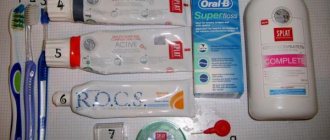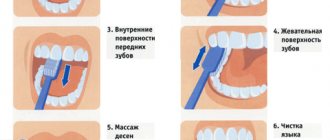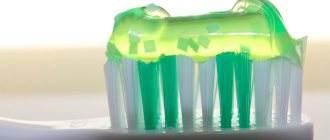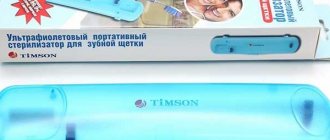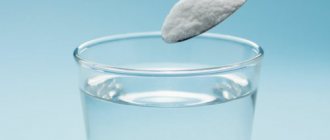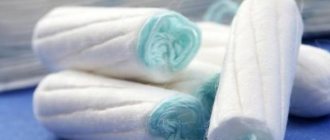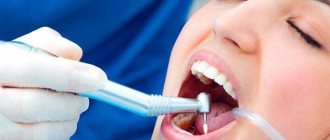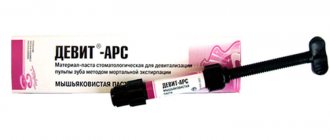A toothbrush is a tool for cleaning teeth. It makes it possible to keep the oral cavity clean, cleaning teeth from food debris and plaque. However, not everyone knows when it needs to be changed, so they use it for years.
If it is not changed in time, then instead of doing good, it will only cause harm. Such an item for cleaning teeth damages tooth enamel, promotes the spread of pathogenic microbes, and leads to inflammation of the gums.
Why does this hygiene item need to be changed quite often?
Any thing or object becomes unusable during use. A toothbrush is no exception. While it is new, you can brush your teeth and remove plaque with it without any problems. After a certain time, the bristles on the toothbrush begin to wear out, break, become deformed and become shaggy.
It is already dangerous to take care of the oral cavity with such an instrument; it can damage teeth and gums. In addition, even if the brush looks good and has not lost its original appearance, but is used for a long time, pathogenic microflora still multiplies in the villi. It will definitely get into the mouth of the owner of the brush and provoke an inflammatory process and dental diseases.
After suffering from viral or infectious diseases, it is advisable to change your toothbrush. This way you can avoid re-infection with the disease.
Where to store your toothbrush when traveling?
There are special containers that prevent dust and dirt from getting on the brush, and also prevent it from changing shape during storage. Such containers can combine disinfecting functions and have a built-in ultraviolet emitter. Before packing your brush into its case, make sure it is thoroughly dry. The presence of moisture promotes the proliferation of pathogenic microbes and mold. You should not store your brush in a container at home. It should stand in a specially designated glass with its head up and be able to dry after use.
Cases for toothbrushes
How many times a year do adults and children need replacement?
Both adults and children should definitely brush their teeth. Parents brush their babies' first teeth using a silicone fingertip. It is very easy to use and easy to clean. The fingertip should be replaced with a new one as it wears out.
As the child gets older, he brushes his teeth with a brush that has bristles. When used, the bristles deteriorate, lose their original appearance and perform their function worse and worse. In addition, over time, pathogenic microbes begin to develop in the toothbrush.
The baby may develop caries, stomatitis, tonsillitis and other diseases. In order not to injure the child’s teeth and gums, as well as to avoid health problems, it is imperative to change the brush with a new one every two to three months, that is, 4-6 times a year.
Adults should monitor not only the health of their children, but also their own. A damaged and long-used personal toothbrush can cause serious damage to the gums and teeth of an adult. As a result, you will have to undergo long and persistent treatment.
Reference! If you change your toothbrush at least every three months, you will be able to avoid many dental diseases.
Video on how often you should change your toothbrush:
How many times should you change a regular brush?
Any, even the most expensive brush has an expiration date. On average, dentists recommend that an adult replace a hygiene item every 2-3 months. The frequency depends on the intensity of use. Some people brush their teeth very aggressively, while others forget to do it altogether. In any case, you should be guided by the condition of the bristles. As soon as they have lost their original elasticity/rigidity, throw them away; the accessory no longer protects against caries and plaque.
Check to see if the item gives off an unpleasant odor, as this is the worst sign. Moreover, you cannot use an accessory if traces of mold are found on it!
We recommend: How to easily debone a herring: we reveal all the secrets
Manufacturers make the task easier by providing the bristles with a special color indicator. As soon as it changes color and becomes lighter, it’s time to buy a new brush. Look for information about the presence of indications on the packages.
Important After suffering an infectious disease - sore throat, flu, etc. — You definitely need to replace your toothbrush, regardless of its age.
If the item fell on a dirty floor, then it is better to spend money on a new purchase. Always compare the cost of a brush and a visit to the dentist in your head.
What happens if you ignore the condition of your toothbrush? The hygiene item will become the main hazard to oral health. Poor cleaning will cause your teeth to become covered with plaque and then tartar. This is fraught with caries. And damage to the gums and their bleeding will lead to serious inflammation of the mucous membrane.
Tip When choosing a new accessory, pay attention not only to the wear indicator, but also to the angle of the bristles - they will clean the space between the teeth well if there is a pronounced angle. The item should also have a cheek and tongue cleaning pad. These areas of the mouth are often ignored by people, although most bacteria accumulate there.
Child's toothbrush
To begin with, the child is selected with a brush with a miniature handle, always made of soft artificial material. It is better to postpone electric tools until the age of 6. At the same time, set it to the most gentle mode in order to preserve thin children's enamel.
The shelf life of a child's brush is no different from an adult's: the same 2-3 months. If your child has had a cold, replace their personal item immediately after recovery.
Tip To make brushing your baby's teeth interesting, buy bright toothbrushes with a textured handle.
When is it time to buy a new one, how do you determine this?
Most toothbrushes have colored bristles, which act as an indicator. With daily brushing of teeth twice a day, the multi-colored bristles begin to discolor after about three months. This is a signal - it's time to replace the brush with a new one. Continued use may be hazardous to health. You should change your toothbrush if:
- heavily polluted;
- has an unpleasant odor;
- cracked;
- The bristles have fallen off or lost their shape.
How to determine that your toothbrush needs to be changed
Three months is the maximum period for using one toothbrush. Even if it is in good condition, it is better to throw it away. Often it becomes unsuitable for proper teeth cleaning earlier. It is imperative to replace it in the following cases:
- You have returned from a trip. Even if you keep it in a case, it may still harbor bacteria.
- After recovery from a disease of infectious etiology. Moreover, we are talking not only about dental pathologies, but also about systemic diseases.
- It is very dirty, fell into dirty water, is worn out and looks unhygienic.
- If another person brushed their teeth with it.
Expensive brushes have indicators: the bristles change color, signaling the need to throw it away. Some people put a patch on the handle with the date of first use written on it.
Nuances for an electric brush
The most effective way to clean your teeth from food debris and plaque is with an electric toothbrush. It comes with a variety of replacement cleaning attachments. If there are not enough attachments, they can be purchased separately.
With use, the bristles on electric brushes also wear out, as evidenced by a tarnished indicator. This happens after about three months of using the device. In this case, you should immediately replace the cleaning head with a new one.
If the electric brush is not equipped with an indicator, you still need to change the brush head after three months of using the device . This will help keep the oral cavity clean and prevent the development of inflammatory processes.
How often should you change your electric toothbrush?
Electric brushes have a longer service life. They are designed to last for several years depending on the specific model. But you will have to change the attachments for it more often. They last for about 3 months, just like a regular brush, since the bristles for them are made of similar materials. After an infectious disease, the nozzle will have to be replaced, even if it was used for a short time.
What happens if you use the old one?
- Over time, more and more pathogenic bacteria accumulate in the toothbrush. If it is not changed on time, serious problems with teeth and gums may occur. There is a high risk of diseases such as stomatitis, caries, periodontal disease or gingivitis.
- Bristles that are deformed due to prolonged use no longer effectively clean teeth and interdental spaces. They begin to damage tooth enamel and injure the gums to the point of bleeding.
- Old toothbrushes do not remove plaque from the surface of teeth well, which will subsequently lead to the formation of tartar and bad breath.
Recommendations for choosing a toothbrush
The answer to the question of how often you need to change your toothbrush largely depends on how well this hygiene item is selected. When purchasing, you should follow these tips:
- if the bristles have different lengths, they cope much better with dirt;
- to clean plaque between teeth, use brushes with long thin bristles;
- if you have problems with your gums, choose brushes with rubber or silicone inserts that perform a massage function;
- if implants or orthodontic structures are installed in the mouth, pay attention to mono-beam brushes;
- choose brushes with a special scraper for cleaning the tongue, because plaque on it is the most common cause of bad breath;
- The bristles should be of medium hardness, unless otherwise recommended by your dentist;
- Expensive brushes have higher quality material, which not only affects the quality of cleaning, but also extends their service life.
How to properly care?
The service life of an individual brush is about three months if you care for it properly, namely:
- After brushing your teeth, rinse thoroughly under running water, shake and dry well.
- Do not boil, as artificial bristles become deformed when exposed to high temperatures.
- Do not press hard on the brush when brushing your teeth. This will lead to rapid deterioration of the bristles, as well as damage to tooth enamel and bleeding gums.
- Periodically place for 30 minutes in a soda or saline solution for disinfection. To prepare a disinfectant liquid, dissolve one teaspoon of soda or salt in a glass of warm boiled water.
- Sterilization can also be done using an ultraviolet lamp. Within 10 minutes, the sterilizer will destroy all germs.
Kitchen sponge and shower sponge
Duration: sponge – 2 weeks (without disinfection) washcloth – up to 1 month
Compare: about 10 million bacteria per square inch nest on a kitchen sponge, while on a rag - 1 million. In this regard, a kitchen sponge is “dirtier” than a toilet seat, microbiologists note. And while only a few of these bacteria can cause serious harm to your health, don't forget that you're also touching many of the other "dirtiest" places in the house - doorknobs, faucets and light switches.
We invite you to familiarize yourself with Veneers for correcting crooked teeth
Conclusion: it is better to disinfect your sponge daily - there are many ways, starting with boiling. But experts say that 99% of germs are destroyed if you put a damp sponge in the microwave for 1 minute or wash it in a dishwasher on a dry cycle. And never wipe the juices of raw meat with a sponge - use paper napkins, which can be thrown away immediately.
How to store?
To store this important item, you should adhere to the following rules:
- Use an individual cup or a special holder. Under no circumstances should you place the brushes of all family members in one container. This way they will come into contact with the bristles, and pathogenic microbes from one brush will end up on the other. When brushing teeth, a healthy person will become infected from a sick person.
- It is not advisable to store a toothbrush in a cabinet located in the bathroom. Lack of light, humidity, elevated temperatures and poor air circulation contribute to the appearance of mold.
- Please note that in a shared bathroom, the brush should not be located next to the toilet . When washed off, it will get splashed with germs, which is not at all hygienic and can lead to the development of various diseases.
- In the container or holder, the toothbrush should be in an upright position, with the bristles facing up . This way the water will drain faster and pathogenic microbes will not have time to multiply.
- Of course, the holder or glass must be clean . If they become dirty, wash them with warm water and soap.
- You cannot put the cap on a wet brush. It is necessary to dry the bristles well first.
- It is recommended to use cases only when traveling. They do not allow air to pass through, so there is a risk of pathogenic microflora appearing.
Attention! The brush that will be placed in the case must be dry.
A toothbrush is a faithful assistant in keeping teeth and gums healthy. It is only necessary to change it once every three months so that accumulated microbes and damaged bristles do not lead to the development of caries, periodontal disease, stomatitis or gingivitis. It is also important to properly care for your brush and follow the rules for storing it.
Why you need to change your toothpaste often
The duration of use of toothpaste is, for the most part, directly related to its intended purpose.
How to choose the right brush for your baby
The first toothbrush for children features a silicone finger massager. This is a transparent cap with short hairs or pimples made of silicone. The brush is placed on the index finger, moistened in boiled warm water and with careful smooth movements, the gums, plaques and first teeth of the child are cleaned. After use, the product is washed with baby soap and rinsed thoroughly in clean water.
From one year old, the baby can begin to use a baby soft brush. For children, choose products only with artificial bristles, since natural bristles accumulate microbes and are an excellent breeding ground for bacteria. In addition, the natural bristles are quite sharp and can damage the gums or enamel of the baby.
A suitable option for a child over one year old would be a brush with soft bristles up to 11 mm high, with a rounded head 18-23 mm long and a rubberized wide handle. It is important that the baby can hold the handle easily and comfortably. The head of the product should cover 2-2.5 teeth. It is good if the bristles are collected in separate tufts, the number of which is 23. Pay special attention to the stiffness of the bristles.
| Hardness degree | From what age can it be used? |
| Very soft (extrasoft, ultrasoft) | 1-5 years |
| Soft | 5-12 years |
| Medium | Over 12-14 years old |
| Hard and very hard (hard) | Only on doctor's orders |
Many people wonder whether a child can use an adult toothbrush. Pediatricians and dentists recommend using these products no earlier than 12-14 years. Popular children's companies producing hygiene products for children's teeth and oral cavity include Canpol, Pigeon, Nuk, Bebe Comfort and Snubs.
They offer sets of several types of brushes that are suitable for different ages of children. From these manufacturers you will find toothpastes and floss for babies. You can also choose well-known brands Colgate, Splat and Oral-b, which produce products for both children and adults. Choose models for children by age.
For kids, choose bright and colorful products to make the brushing process interesting and quickly teach your child to brush their teeth on their own. Today, manufacturers offer a lot of different designs, including products with characters from popular cartoons and rattle handles. Particularly popular are models that change color throughout the procedure, thereby indicating how much time is left until the end of the process. Read more about how to teach your child to brush their teeth on their own here.
Is it possible to brush your teeth longer than the allotted time?
Brushing your teeth with a brush that has served its purpose is dangerous for the condition of your gums and teeth. Minimal harm from use is poor cleaning. Plaque and bacteria that accumulate daily can cause major problems, such as the formation of tartar and caries.
If bacteria get into the micro-wounds on the gums, the inflammatory process will not take long to occur. If left untreated, gingivitis can lead to periodontitis and subsequent tooth loss. Therefore, you should not neglect the established sanitary and hygienic rules. Knowing how often you need to change your regular or electric toothbrush will protect you from possible opportunistic infections and maintain your oral health.
Recommendations for use and storage
How many times you change your toothbrush is an individual decision. Some perform this procedure quite often, others neglect this simple rule. The most important thing in both cases is not to exceed the permissible period of use, which is three months. You also need to adhere to the rules for storing and further using the hygiene item:
- After each use, wash the brush with toilet soap. This is due to the fact that there are a large number of microbes in the mouth, even in a completely healthy person. Thus, some of the bacteria are able to remain on the bristles.
- It is recommended to clean the brush before use, as bacteria from the environment may appear on it. If such bacteria enter your mouth, you can get various types of diseases.
- Most families have one container for storing all brushes, which is strictly prohibited, since contact can transfer bacteria from one item to another. Each brush must be kept separate from the others; if this is not possible, then special protective caps must be used.
- You should never judge the suitability of brushes by their appearance. Sometimes an attractive appearance can last for years, so this is not an indication that the life of the toothbrush has not yet come to an end.
- You can destroy bacteria and their further reproduction using a sterilizer, but its purchase is justified if an expensive brush is used.
- Most people use cases. It is worth abandoning them, as they provide optimal conditions for the growth of bacteria.
We suggest you read: Why teeth hurt when you have a cold - What to do if your teeth hurt when you have a runny nose
Perfumery
Duration: from 3 to 5 years
The main enemies of any perfume are daylight and elevated temperatures, so it is best to store fragrances in a dark closet, away from radiators and other heat sources. By the way, a refrigerator is a good idea, that’s what perfumers themselves do. However, it is important to remove products that absorb odors, such as oil, away.
We suggest you familiarize yourself with Caring for dental implants after installation, cleaning rules
Important: connoisseurs say that a high-quality expensive perfume is like a good wine; it only gets better with time. And remember that citrus notes disappear faster than others, and the most persistent aromas are chypre, oriental and woody.
